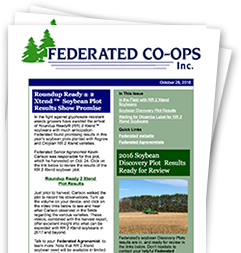Seed Choices Today Determine Herbicide Options Tomorrow

It's time to lock in seed choices for 2019, but before that happens, consider weed control.
“The seed and seed traits growers purchase now determine the herbicide options for 2019,” said Kevin Carlson, Federated’s senior agronomist, “for soybeans and corn alike . . . though soybeans are much more challenging.”
“Spend some time thinking about the herbicide program [you plan to use] for ’19,” said Carlson, especially for soybeans. Ask these questions:
- What varieties and traits are needed for weed control in ’19?
- What is the weed history in ’18 and previous years?
- Consider the recent and past weed challenges.
- Look at fields throughout the area, “on your own and other farms,” said Carlson.
- Are there any resistance problems?
- Resistance will spread through harvesting and tillage operations (“combines are the worst culprit,” said Carlson), and there’s no way to avoid that.
- What treatments have and have not worked?
Seed traits are chosen for the post-emerge program and the problems that lie ahead, but, said Carlson, “they all start with a good pre-emerge program for weed resistance management.”
Carlson shared a quote he’s heard in agronomy circles: “Post-emerge programs are just a clean-up of the pre-emerge program, not the primary way to control weeds.”
Federated Agronomists focus their time and training on weed resistance management because “no matter what trait comes out in the marketplace [and there will always be new traits], it doesn’t matter . . . it’s all about weed resistance management and using a good pre-emerge program.
“While things are fresh in your mind about weed resistance and control in ’18, think about what’s ahead. You have to have a solid weed control program,” said Carlson, acknowledging that it’s very difficult to cut costs out of a good weed control program. Trimming that budget is really difficult.
From a crop budgeting perspective, especially for corn, lime and crop nutrients are a very large budget item. Carlson noted the importance of making good decisions that “maximize the return on investment in that category.”
Crops that get a good start with the right nutrients prove themselves worthy of the budget expenditures with significantly improved yields. “This is a fundamental basic that we need to address,” said Carlson.
Check the “sufficiency levels” in the soil by soil test and apply the nutrients to “get the crop response we want,” he said. Nutrient and input budgets have to be based on real information – soil tests and previous results.
“Nitrogen (N) and sulfur (S) rates really drive bushels,” said Carlson, and phosphorous (P) and potassium (K) have to be in the soil to get the N and S response. “We see the response in the corn crop today,” and it’s especially demonstrated in fields using Federated’s precision platform. “There is a very good ROI on nutrient management and input costs,” he said. Growers need to consistently factor those costs into their budgets.
See this link for a valuable report from the University of Minnesota on P and K response in corn.
“Bushels are pulling growers into the black in 2018,” Carlson observed. A little better crop price and better than expected yields translate into more profit for growers who managed their crops well.
“Bushels matter,” said Carlson, noting that there is generally a “very good corn crop” across Federated’s service areas (with some exceptions due to spring weather and poor emergence). Watch the Agronomy Update for results of an emergence study done in cooperation with Rosen’s.
Talk to your Federated Agronomist with questions about seed and seed traits – and the herbicides to go with them – before you make your 2019 purchases.


